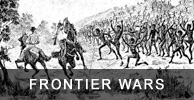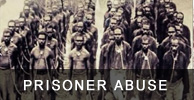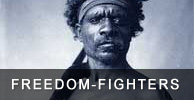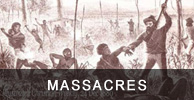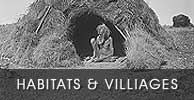Victoria's silent shame
Chris Munro Tracker 5 July 2013

An artists impression of a Kurnai camp at Lake Tyres in Victoria
Writing about Aboriginal history can be a taxing exercise. Any writer, especially an Aboriginal one - who's spent some time in this space will tell you as much.
As a writer, your first instinct is to of course tell the truth, but sadly, when it comes to the history of Aboriginal tribes since invasion, the facts are almost always grim.
It whittles you down too. There's such an enormous volume of destruction, death and negativity swirling through this country's historical veins, it really does start to dawn on you just why Australia displays such a unique brand of social and intellectual immaturity when it comes to race.
Australia's head in the sand approach to 'contact' on the Australian frontier is also legendary. 200-odd years on and Australian children are still denied the truth about the so-called 'founding' of this nation. That said though, a few paragraphs of this Footprints story about contact in Victoria and you can perhaps see why ignorance and silence was widely practiced.
But let's start this tale further south in Tassie.
Hands down the single most appalling blight on the history of this nation has to be the near genocide of Aboriginal people in Van Diemen's Land. It stands as one of the most brutal and vicious acts of ethnic cleansing in the history of the human race. No mean feat.
Indeed some of the acts perpetrated against innocent Aboriginal men, women, even babies in Tasmania truly make your blood run cold.
White invaders had come ever so close to extinguishing Tasmanian Aboriginals all together, and whilst these acts are relatively well known in Aboriginal circles, most Australians wouldn't have a clue one of the world's most horrendous mass murders took place on home soil.
Likewise, 99.9 percent of Victorians wouldn't have any inkling they inhabit a stolen landmass that's home to perhaps the second most severe act of near genocide in Australia; the massacres of the Kurnai people between 1840 and 1851.
The timing's important too. The Victorian killings started in earnest not long after seven men had been hanged for murdering 28 Aboriginal women and babies in horrific circumstance at Myall Creek in north western NSW.
Death by hanging was certainly a deterrent, but clearly not punishment enough for the invaders of the south. They simply went about their human 'hunting' more tactically, using a code of silence and the slow dilution of time to hide their evil.
Whites arrived in the Gippsland region east of Melbourne around 1830 with 'settlement' taking place very quickly, much to the displeasure of the Kurnai.
Just like the rest of Australia, the Kurnai's hunting and ceremonial lands were simply stolen without discussion by the invaders, their arrogance and warped sense of superiority spurring them on.
From the great divide in the west down to Wilson's Prom in the south, all the way out to the Ninety Mile beach on the coast, the Kurnai were systematically slaughtered where they stood.
Fighting for their lives, they began to hit back, taking several white lives, scattering stock and burning 'settlers' huts where they could.
The guerilla conflict continued, but the Kurnai, facing superior firepower, were taking heavy loses and the pace was about to pick up.
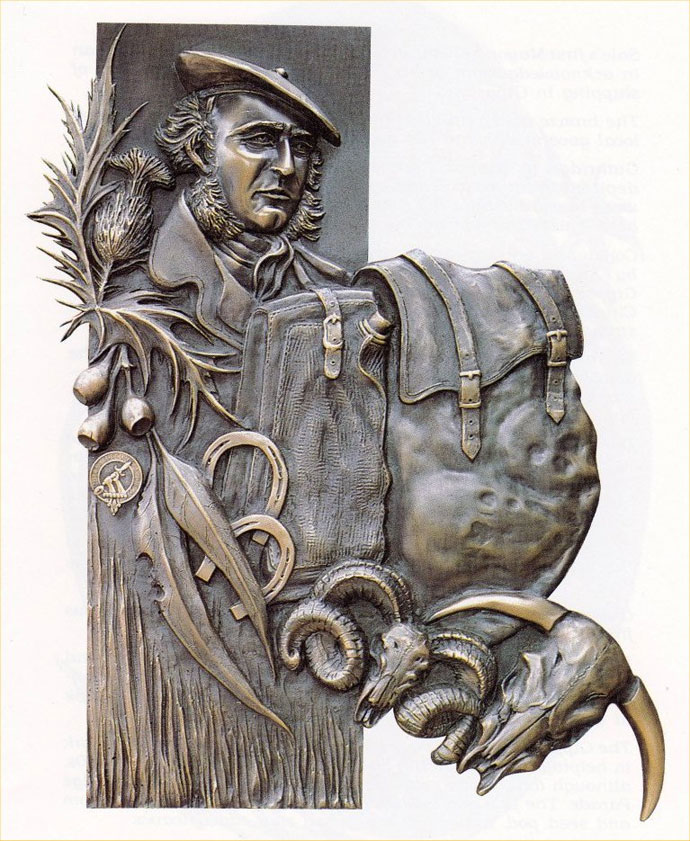
Note the scull 'trophies' in his saddle bags.
UPDATE APRIL 2018 - the electoral commission has announced the renaming of the McMillan Electorate to Monash (A European war hero)
In 1840, a Scotsman by the name of McMillan came to the region, employed by Lachlan Macalister who 'owned' a station they called 'Nuntin.'
McMillan had not long before driven a hundred head of cattle into the region, convinced of its pastoral potential and he was greedy for power, money and control.
The Kurnai scattered McMillan's cattle into the bush not long after his arrival, aware of the damage they were causing to feeding grounds and the competition they provided to local wildlife.
McMillan was irate. He planned revenge on the Kurnai and his response was as immediate as it was savage.
McMillan gathered stockmen from Nuntin and surrounding properties, forming a well-armed posse.
For the next few days McMillan and his men wandered across the region killing any Aboriginal people they spotted. There was no record of the numbers killed, but estimates suggest around 50-60 Kurnai were slaughtered using swords, shot guns and rifle butts.
Their deaths were never avenged. But three years later, the Kurnai struck back at the posse form Nuntin. They orchestrated a revenge attack on Donald Macalister, who was the nephew of Nuntin's owner, Lachlan Macalister.
You see, young Donald had thought it sidesplitting to one-day pour a shovel full of hot fire coals onto the feet of a respected Kurnai warrior. The Kurnai's revenge killing would eventually lead to one of the most brutal known massacres of Aboriginal people in Victoria and indeed the country.

Kurnai kids play at the Lake Tyres Aboriginal mission in Victoria (1950s).
Dubbed the massacre of Warrigal Creek, the killings followed shortly after the Kurnai tore Donald Macalister from his horse and speared him in revenge for the mutilation of one of their own.
Few words can describe the white reprisal at Warrigal Creek. It was nothing short of pure evil.
Again, it was a familiar face, one who'd now made a career as a mass murderer of Aboriginal people - who lead the charge. McMillan was incensed at the murder of Macalister, who was a friend. So much so he was determined to teach the Kurnai a lesson once and for all.
A posse of up to 20 armed men rode off in search of the Kurnai and soon found a large number camped by a waterhole on Warrigal Creek.
The devil's henchmen split up, some riding up stream of the camp, other down. The instructions were simple. No black was to survive, there'd be no hostages and not a word of the ordeal was to be spoken afterwards.
Within half an hour the Kurnai, mainly women and children, were surrounded and completely unaware of what horrors awaited them.
As the signal went up, a barrage of gunfire simultaneously erupted around the camp, as all hell broke lose.
Some Kurnai had time to turn and run, but they didn't get far. The terrified women and children were cut down by sword wielding murderers only meters into the scrub. Others jumped into the waterhole, plunging into the inky blackness in a vain attempt at escape.
As each one emerged for breath, they were gunned down until the large body of water ran a deep red.
One young boy miraculously managed to evade death that night, despite a bullet through his eye. He was chained by McMillan and forced to lead the bloodthirsty mob onto the next Kurnai camp.
McMillan's bloodlust was now at fever-pitch, as he went from camp to camp murdering anything that dared move.
Warrigal Creek was a disaster for the Kurnai. As many as 150 people were slaughtered in the most depraved of circumstances and ghoulishly, their remains were to be uncovered throughout the creek after rain - for decades after the tragedy.
Just when thought it couldn't get any worse for the Kurnai, it of course did.
Interwoven into the patchwork of casual killings that occurred daily in the region was a rumor doing the rounds of a shipwrecked white woman supposedly held captive by a Kurnai warrior in the foothills of the Snowy Mountains.
The Kurnai had seen it all. The whites needed no prompting to kill Aborigines as it was, but now they had the outrage of a hapless white woman taking up with a wild savage.
It was literally open season.

Kurnai elders at Lake Tyres Gippsland, Victoria.
The 'savage' in question was in fact a celebrated warrior by the name of Bunjil-ee-nee and he was as tough as they came.
Almost impossible to track, Bunjil-ee-nee wasn't going to be easy to get a hold of. Two separate parties sent off from Melbourne into the mountains after the mystery woman, but both with very different approaches.
The first party was led by Captain William Dana, who was put in charge of a large contingent of the much-feared native police. 'Psychotic', would be the best word to describe Dana. He was hell bent on killing, and now he had the perfect excuse, and the backing of the colony.
He scoured the coastline for weeks seeking the great Bunjil-ee-nee and his white bride.
Along the way Dana killed indiscriminately. The competing party, led by a more stable character by the name of De Villiers, would later find the piles of Kurnai remains left at campsites along the coast. One of the De Villers party later wrote.
'They (Kurnai) certainly are a very fine race, few under six feet and stout in proportion. It is a great pity that powder and ball seems to be their fate, as the settlers think no more of shooting them than they do of eating their dinners and from what we can learn, some fearful slaughters have taken place.'
Disastrously for the Kurnai, Dana and his native police eventually reached the Snowy River in the Australian Alps days before De Villiers. Dana and his gang rode upstream killing groups of Aborigines as they came across them.
Thinking they'd finally cornered the mighty Bunjil-ee-nee, Dana and his gang surrounded a large group of Kurnai who'd made camp far up a small tributary of the Snowy River assuming they'd be safe from the murderous horsemen loose in their country.
Most were slaughtered in their possum skin rugs as they sheltered from a cold and windy winter's night. Only two Elders survived the carnage but thankfully they later escaped from Dana's men.
In the following years the Gippsland and high country region was won purely on violence and murder. The whites simply killed over and over and over until Kurnai resistance and population numbers were whittled down to nearly nothing.
Children were raped, mutilated and killed. Women protecting their babies weren't pitied either. The lives of these mothers and their infant babies were often dashed out by the butt of a rifle, because expending ammunition on such easy targets was deemed wasteful.
In only fifteen short years one of the strongest tribes in Victoria had all but been wiped out. Save for a handful of survivors living day-to-day around stations in the high country and Lake Tyres area, a people with a 70,000-year history had all but been systematically removed from this earth in the blink of an eye.
Sometimes it really is difficult to learn the truth, and even harder to put that truth into words.
And so its my guess that Victorians will never know the true story of the ground they walk on, nor the horrendous way in which it was 'settled.'
Indeed Australians will continue to use the tactic their forefathers used to great effect - the dilution of time, and the perpetuation of silence.
 "Abo's", the frontier wars and the squeaky clean invaders!
"Abo's", the frontier wars and the squeaky clean invaders!
 The letters of Henry Howard Meyrick
The letters of Henry Howard Meyrick
 Mapping the massacres of Qld Aboriginal society
Mapping the massacres of Qld Aboriginal society
 The Rufus River Massacre - Lake Victoria South West NSW
The Rufus River Massacre - Lake Victoria South West NSW
 Coranderrk: First Nations Farmers and Market Gardeners
Coranderrk: First Nations Farmers and Market Gardeners

